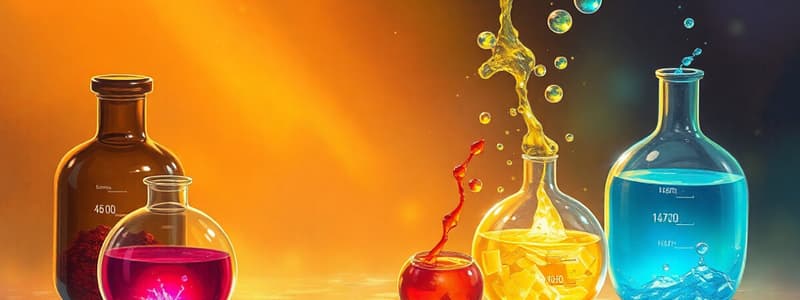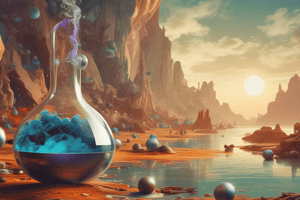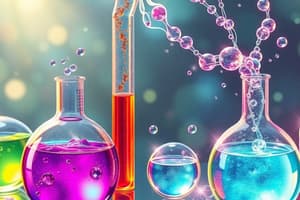Podcast
Questions and Answers
Match the following terms with their definitions related to solutions:
Match the following terms with their definitions related to solutions:
Solute = The substance that is dissolved in a solution. Solvent = The substance that dissolves the solute, present in greater amount. Aqueous solution = A solution where the primary solvent is water. Dissociation = The process where ionic or polar solutes separate into ions in a solvent.
Match the types of solutions with their saturation levels:
Match the types of solutions with their saturation levels:
Saturated solution = Contains the maximum amount of solute that can dissolve at a given temperature, with excess solute potentially settling out. Unsaturated solution = Contains less solute than the maximum it can dissolve at a given temperature. Supersaturated solution = Contains more solute than it can theoretically dissolve at a given temperature, often unstable. Electrolyte solution = A solution containing ions, allowing it to conduct electricity.
Match the types of electrolyte solutions with their dissociation behavior:
Match the types of electrolyte solutions with their dissociation behavior:
Strong electrolyte = Dissolves and completely dissociates into ions. Weak electrolyte = Dissolves but only partially dissociates into ions. Nonelectrolyte = Dissolves but does not dissociate into ions. Saturated solution = A solution with the maximum amount of dissolved solute.
Match the reaction types with their descriptions for reactions in solutions:
Match the reaction types with their descriptions for reactions in solutions:
Match the concentration units with their mathematical expressions:
Match the concentration units with their mathematical expressions:
Match the effect of temperature on solubility with the type of compound:
Match the effect of temperature on solubility with the type of compound:
Match the following terms with their description
Match the following terms with their description
Match the type of solution with its behavior
Match the type of solution with its behavior
Match the term with the type of substance
Match the term with the type of substance
Match the term with its respective meaning for performing calculations
Match the term with its respective meaning for performing calculations
Match each term with its definition in the context of solutions.
Match each term with its definition in the context of solutions.
Match each concept with its application in solution chemistry.
Match each concept with its application in solution chemistry.
Match each process with the factor that affects its rate in solution chemistry.
Match each process with the factor that affects its rate in solution chemistry.
Match each solution type with its characteristic concentration state.
Match each solution type with its characteristic concentration state.
Match the term to which process is useful in the context of calculations
Match the term to which process is useful in the context of calculations
Match each type of equation with its role in representing chemical reactions in solutions.
Match each type of equation with its role in representing chemical reactions in solutions.
Match the concentration unit with its application in expressing very low concentrations accurately.
Match the concentration unit with its application in expressing very low concentrations accurately.
Match the change to a solution with its effect on concentration or volume as indicated by the dilution equation.
Match the change to a solution with its effect on concentration or volume as indicated by the dilution equation.
Match the characteristic of what a solution needs to have in order to become an electrolyte.
Match the characteristic of what a solution needs to have in order to become an electrolyte.
Match each feature with its purpose
Match each feature with its purpose
Flashcards
Heterogeneous mixture
Heterogeneous mixture
Not evenly mixed; components are easily distinguishable.
Homogeneous mixture
Homogeneous mixture
Evenly mixed at a microscopic level; appears uniform throughout.
Solute
Solute
The substance that dissolves in a solvent.
Solvent
Solvent
Signup and view all the flashcards
Aqueous solution
Aqueous solution
Signup and view all the flashcards
"Like dissolves like"
"Like dissolves like"
Signup and view all the flashcards
Dissociation
Dissociation
Signup and view all the flashcards
Saturated solution
Saturated solution
Signup and view all the flashcards
Unsaturated solution
Unsaturated solution
Signup and view all the flashcards
Supersaturated solution
Supersaturated solution
Signup and view all the flashcards
Electrolyte solution
Electrolyte solution
Signup and view all the flashcards
Strong electrolyte solution
Strong electrolyte solution
Signup and view all the flashcards
Nonelectrolyte solution
Nonelectrolyte solution
Signup and view all the flashcards
Weak electrolyte solution
Weak electrolyte solution
Signup and view all the flashcards
Soluble
Soluble
Signup and view all the flashcards
Insoluble
Insoluble
Signup and view all the flashcards
Molecular Equation
Molecular Equation
Signup and view all the flashcards
Overall ionic equation
Overall ionic equation
Signup and view all the flashcards
Net ionic equation
Net ionic equation
Signup and view all the flashcards
Molarity
Molarity
Signup and view all the flashcards
Study Notes
Mixtures
- Heterogeneous mixtures are not evenly mixed
- Homogenous mixtures are evenly mixed solutions
Solutions
- Solutions consist of two or more parts
- The solute is the part that gets dissolved
- The solvent is the part that does the dissolving and makes up the major amount of the solution
- Aqueous solutions contain chemicals with H2O, for example, MgCl2 (aq)
"Like Dissolves Like"
- Polar substances dissolve other polar, ionic compounds
- Nonpolar substances dissolve other nonpolar compounds
- Polar substances do not dissolve nonpolar substances
Dissolving Process
- Dissolving is called dissociation
- Ionic or polar solutes are broken apart by H2O
- The lattice crystal slowly breaks apart in the process
Speeding up Dissolving
- Mixing or agitating increases solute and solvent interactions
- Heating speeds up movement and the rate at which water breaks apart
- Breaking up the solute increases the speed of dissolving
Bonds in Solutions
- Covalent bonds remain as molecules
- Ionic bonds break into atoms
Types of Solutions
Saturated Solution
- At saturation point, the solute only dissolves a fixed amount
- A saturated solution has dissolved all it can, and the excess solute forms a solid chunk
Unsaturated Solution
- An unsaturated solution has dissolved some solute but can dissolve more
Supersaturated Solution
- A supersaturated solution contains more dissolved solute than dictated by temperature
Electrolyte Solutions
- Electrolyte solutions have ions present in the solution
- 100% of the dissolved chemical splits into ions in an electrolyte solution
- Nonelectrolyte solutions have 0% of the dissolved chemical splitting into ions
- Weak electrolyte solutions have 5% of the dissolved chemical splitting into ions, while 95% remains a compound
Chemical Reactions for Dissolving
- The goal is to write a reaction that transforms a chemical from a solid to an aqueous state
- An ionic solution results from a dissociation reaction
- Examples of such reactions include CuF2, Cu2SO4, Al2O3, and FeBr3
Solubility
- Solubility is at saturation point
- Soluble substances have most or all of the chemical dissolving into ions
- Insoluble substances have some ions dissolving but not much/none
Dissociation Reactions
- Soluble Example: NaCl (100g) dissociates into Na^+ + Cl^- (100 ions)
- Insoluble Example: AgCl (90% solid) dissociates into Ag^+ + Cl^- (2g ions)
Mixing Two Solutions
- Mixing two solutions has two possible outcomes:
- Nothing happens (no reaction)
- Precipitate reaction (double replacement reaction) expressed as: XY (aq) + AB (aq) → AY (s) (ppt) + XB (aq)
- Example: Pb(NO3)2 + KI → PbI2 + KNO3
Dissociation Reactions: 3 Main Reactions
- Molecular Equation: An overview of what happened
- Overall Ionic Equation: Depicts what actually happened
- Net Ionic Equation: Shows what actually reacted
- When given two solutions, know how to find all of these and Remember to balance
- Examples: Na2CrO4 and Al(NO3)3, K3PO4 and CuNO3, Sr3N2 and Na2SO4
Measuring Solution Concentrations
Measuring Concentrations
- Parts per hundred (%)
- Parts per million (ppm)
- Parts per billion (ppb)
- Calculation: Part/whole times 100/1 million/1 billion = %/ppm/ppb
Molarity
- Molarity (M) = moles of solute/liters of solution
Molarity Calculations
- Molarity = Moles of solute / Liters of solution
- "[x]" represents the concentration of x
Concentration of Ions
- Find the concentration of the molecule and then multiply by how many cations/anions there are to find the concentration of the cations/ions
- Multiply by the concentration of the molecule by both and then add the two products together to find the concentration of the ions
Dilution
- Dilution involves increasing/decreasing the volume of a solution
- Types of dilution problems:
- Dilution of a solution
- Reaction based (multiple solutions)
- Dilution Equation: M1V1 = M2V2
- M = molarity, V = volume
- Molarity increases and volume decreases after solution is diluted
Volume Changes in Dilution
- Types of volume changes:
- Volume becomes “V2=___”
- Add ____ to the solution (V2= V1+____)
- Example: 50mL of 2.0M KCl solution has 200mL added, so V2=200+50=250mL
Stoichiometry with Molarity
- Mass of ppt will form if 250mL of .95M VCl2 reacts with excess in the reaction: Pb(NO3)2+2VCl2→PbCl2+2V(NO3)4
- Volume of 4.20M Li2CO3 used to make 700.g of ppt in the reaction: 3Li2CO3+Fe2(SO4)3→3Li2SO4+Fe2
- Mass of ppt will form if 200.mL of 3.5M Pb(NO3)2 reacts with 100.0mL of .75M VCl4a in the reaction: 2Pb(NO3)2+VCl4→2PbCl2+V(NO3)4
- The [anions] of 5M of calcium phosphate
- Mass of ppt is formed when 600.mL of 1.7M K2CrO4 mixed with excess ZnF2
- How many g of CaCl2 was needed to make it, if A.75L solution contains 3.5M Cl^-
Solution Review
- Define:
- Solute
- Solvent
- Saturated solution
- Unsaturated solution
- Electrolyte solution
- Nonelectrolyte solution
- To become an electrolyte solution, a compound needs to split into ions when dissolved in a water solution.
- "Like dissolves like" is referring to intermolecular forces
- A polar solute will dissolve in a polar solvent
- A nonpolar solute will dissolve in a nonpolar solvent
- An ionic compound will dissolve in a polar solvent
- Aqueous means that the chemical is dissolved in water
- How to write the Dissociation reaction for the following compounds:
- Fe2(SO4)3
- AlBr3
- Tungsten (V) fluoride
Calculations
- Given 22 grams of gold mixed with 16 grams of silver what the percent gold in 14-karat gold?
- Given a 555 kg stone contains 3.7 grams of gold. What is the concentration of gold in parts per million?
- How to calculate [K3PO4], if mixing 333 g K3PO4 into water to make a 875 mL solution?
- What is the [cations] in 0.45 M tungsten (V) sulfate?
- Given 750 grams precipitated when 500. mL of Li2S and 500. mL of excess Au(ClO3)3 solutions mixed together, what was the concentration of the Li2S solution in the following reaction: 3Li2S(aq) + 2Au(ClO3)3 (aq) → Au2S3 (s) + 6LiClO3 (aq)
- If 111 g FeCl3 is dissolved into a 555 mL solution, what is the concentration of the solution? What is the concentration of the anions in the solution?
- What is the volume needed to take 244 g KCl and make a 1.45 M solution?
- If mixing 35 grams of NaBrO3 into a 150. ml solution when a student mistakenly added 100. mL of water to the solution, what is the concentration after this mistake?
- If a Jar with 10.0 L of .650 M Fe(ClO3)3 solution is left out in the sun for the summer and concentration of anions in the new solution, when I get back to class and find there is only 1.30 L of solution left?
Studying That Suits You
Use AI to generate personalized quizzes and flashcards to suit your learning preferences.




